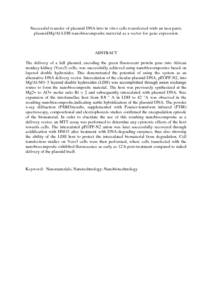Citation
Masarudin, Mas Jaffri and Yusoff, Khatijah and Abdul Rahim, Raha and Hussein, Mohd. Zobir
(2009)
Successful transfer of plasmid DNA into in vitro cells transfected with an inorganic plasmidMg/Al-LDH nanobiocomposite material as a vector for gene expression.
Nanotechnology, 20.
pp. 1-11.
ISSN 1361-6528
Abstract
The delivery of a full plasmid, encoding the green fluorescent protein gene into African monkey kidney (Vero3) cells, was successfully achieved using nanobiocomposites based on layered double hydroxides. This demonstrated the potential of using the system as an alternative DNA
delivery vector. Intercalation of the circular plasmid DNA, pEGFP-N2, into Mg/Al-NO−3 layered double hydroxides (LDH) was accomplished through anion exchange routes to form the
nanobiocomposite material. The host was previously synthesized at the Mg2+ to Al3+ molar ratio Ri = 2 and subsequently intercalated with plasmid DNA. Size expansion of the interlamellae host from 8.8 ° A in LDH to 42 °A was observed in the resulting nanobiocomposite,indicating stable hybridization of the plasmid DNA. The powder x-ray diffraction (PXRD)results, supplemented with Fourier-transform infrared (FTIR) spectroscopy, compositional and
electrophoresis studies confirmed the encapsulation episode of the biomaterial. In order to elucidate the use of this resulting nanobiocomposite as a delivery vector, an MTT assay was performed to determine any cytotoxic effects of the host towards cells. The intercalated pEGFP-N2 anion was later successfully recovered through acidification with HNO3 after treatment with DNA-degrading enzymes, thus also showing the ability of the LDH host to protect the intercalated biomaterial from degradation. Cell transfection studies on Vero3 cells were then performed, where cells transfected with the nanobiocomposite exhibited fluorescence as early as 12 h post-treatment compared to naked delivery of the plasmid itself.
Download File
![[img]](http://psasir.upm.edu.my/16887/1.hassmallThumbnailVersion/Successful%20transfer%20of%20plasmid%20DNA%20into%20in%20vitro%20cells%20transfected%20with%20an%20inorganic%20plasmidMg.pdf)  Preview |
|
PDF (Abstract)
Successful transfer of plasmid DNA into in vitro cells transfected with an inorganic plasmidMg.pdf
Download (185kB)
| Preview
|
|
Additional Metadata
Actions (login required)
 |
View Item |

